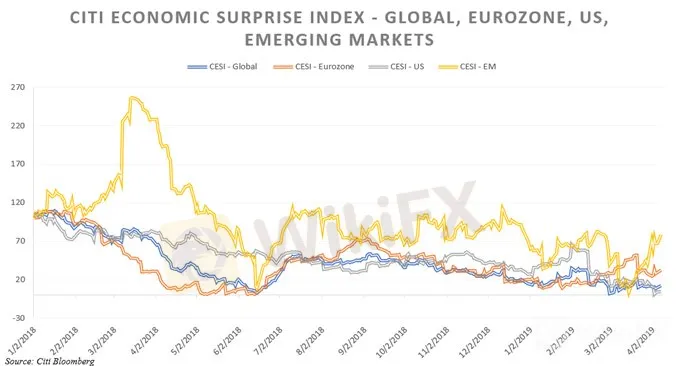简体中文
繁體中文
English
Pусский
日本語
ภาษาไทย
Tiếng Việt
Bahasa Indonesia
Español
हिन्दी
Filippiiniläinen
Français
Deutsch
Português
Türkçe
한국어
العربية
Euro at Risk From US-EU Tariff Threat - IMF, World Bank Meeting Ahead
Abstract:The Euro may suffer as the US and EU prepare for what may be another cross-Atlantic trade war as the IMF and World Bank prepare to discuss the global outlook this week.
TALKING POINTS – EURUSD, US TARIFFS, EU-US TRADE WAR, IMF WORLD BANK ANNUAL SPRING MEETING
USTR Robert Lighthizer proposes list of tariffs against EU
US-EU trade war fears rise as the global economy slows
Markets eyeing upcoming IMF, World bank spring meeting
See our free guide to learn how to use economic news in your trading strategy!
US-EU TRADE TENSIONS RISING
As the US and China close what may be the end of a very painful chapter on trade wars, a new one may have just weaved into the narrative. On Monday, US Trade Representative Robert Lighthizer put forth an $11 billion list of tariffs the Trump Administration is intending on leavying against the EU. This comes amid dissatisfaction with the EUs subsidies for the aerospace giant Airbus.
Some of the import duties would include both soft and hard commodities ranging from wine and various cheeses to helicopters and industrial parts. The dispute first emerged in 2004 – and still has not had a definitive ruling – when the US brought the matter to the attention of the WTO which outlined how the EUs subsidies negatively impacted US commerce.
Lighthizer justified the threat of tariffs through citing section 301 of the Trade Act of 1974, which allows the President to take the necessary action – which includes retaliation – to end any countrys practice that violates WTO rules. The kinds of items listed suggests US policymakers are targeting key industries in core Eurozone including France and Germany as a way to pressure key member states.
“Our ultimate goal is to reach an agreement with the EU to end all WTO-inconsistent subsidies to large civil aircraft. When the EU ends these harmful subsidies, the additional U.S. duties imposed in response can be lifted” Lighthizer stated. However, getting all parties to the table to talk may be difficult considering recent failed efforts and an overall erosion of their political and economic relationship since 2018.
For Europe, the timing could not be worse. Eurozone growth has been abysmal with last week‘s release of German factory orders that put a dent in the Euro’s performance and soured overall market sentiment. This comes as France continues to deal with the Yellow Vest Protests, Italy wrestles with a recession with the German economy not far behind. The last thing the region needs is another headwind.
Furthermore, this week, the IMF and World Bank will be holding their annual spring meeting where policymakers will weigh in on the outlook for global growth and potential risks facing the financial system. Fears over a global slowdown will likely dominate the topic of discussion as the three largest economies –the US, China and EU – decelerate as the geopolitical landscape shifts into unpredictable territory.

If the global outlook is more pessimistic than anticipated, cycle-sensitive assets like the Australian and New Zealand Dollars along with stock indices will likely suffer. Conversely, the US Dollar, Japanese Yen and Swiss Franc may catch haven bids and outperform. In the event of an EU-US trade war breakout, European assets would suffer with the Swiss Franc possibly emerging as the regional champion.
Disclaimer:
The views in this article only represent the author's personal views, and do not constitute investment advice on this platform. This platform does not guarantee the accuracy, completeness and timeliness of the information in the article, and will not be liable for any loss caused by the use of or reliance on the information in the article.
Read more

AUD/USD Eyes Upside on Potential Loan Prime Rate Cut in China
Australian Dollar eyes China’s monthly 1- and 5-year Loan Prime Rate fixing. Traders await news over US/China oil inventory releases and Biden’s Fed pick. AUD/USD downside may continue as bearish SMA crossover nears.

Australian Dollar Eyes Chinese Economic Data, Will AUD/USD React
Australian Dollar is in focus with Chinese economic data on tap to kick off APAC trading. Japan’s Q3 GDP crossed the wires at -3.0% q/q, missing analysts’ expectations of -0.7%. AUD/USD looks to move higher after a Bullish Engulfing candlestick pattern forms

Japanese Yen Technical Analysis: USD/JPY, AUD/JPY. Are They Establishing Ranges?
JAPANESE YEN, USD/JPY, AUD/JPY - TALKING POINTS

GBPUSD Dips, EURUSD Steady, SNB Intervening in Swiss Franc (CHF) - US Market Open
GBPUSD Dips, EURUSD Steady, SNB Intervening in Swiss Franc (CHF) - US Market Open
WikiFX Broker
Latest News
Bitcoin in 2025: The Opportunities and Challenges Ahead
BI Apprehends Japanese Scam Leader in Manila
Join the Event & Level Up Your Forex Journey
Is There Still Opportunity as Gold Reaches 4-Week High?
Bitcoin miner\s claim to recover £600m in Newport tip thrown out
Good News Malaysia: Ready for 5% GDP Growth in 2025!
Breaking News! Federal Reserve Slows Down Interest Rate Cuts
Beware: Pig Butchering Scam Targeting Vulnerable Individuals
This Economic Indicator Sparks Speculation of a Japan Rate Hike!
Dutch Law Student Arrested for €4.5 Million Crypto Scam
Currency Calculator






